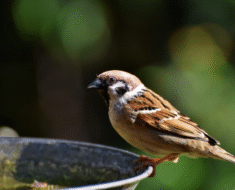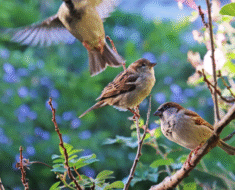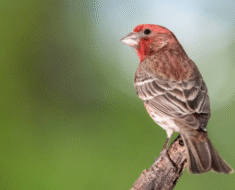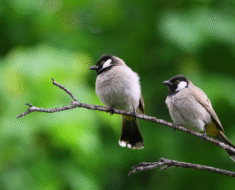
If you’ve ever wandered through a thicket in early summer and heard a sharp “chit-chit” call without spotting a single bird, you may have been near a MacGillivray’s Warbler. These shy little songbirds are notoriously difficult to see—but incredibly fascinating once you get to know their rhythms. One of the most intriguing things about them is how their behavior changes with the seasons.
In this post, we’ll dig into how this secretive warbler adapts throughout the year—where it goes, what it eats, how it breeds, and why its seasonal shifts matter. Whether you’re a backyard birder or a field naturalist, understanding their patterns can make your next encounter a lot more meaningful.
Key Takeaway
By the end of this post, you’ll understand how the MacGillivray’s Warbler responds to seasonal changes and how to better spot or support them in the wild.
- Learn how migration affects their location and habits
- Understand nesting and breeding season behaviors
- Know what they eat across different seasons
- Spot subtle changes in vocalizations and appearance
- Explore ways you can help protect their seasonal habitat
1. Where They Go: Migration Patterns You Might Miss
One of the defining seasonal behaviors of this species is its long-distance migration. The MacGillivray’s Warbler breeds in western North America and spends winters as far south as Central America.
Spring Migration (March–May):
- They begin arriving in U.S. breeding grounds in late March or April.
- Routes generally follow the Pacific Flyway, passing through Mexico and the southwestern U.S.
- Stopovers include dense brushy habitats—think overgrown fields or creek beds.
Fall Migration (August–October):
- Fall departures start as early as mid-August.
- Juveniles often leave later than adults, lingering into October.
- They move south to overwinter in areas like Guatemala, Honduras, and even northern Colombia.
Birdwatcher Tip: During migration, they’re more likely to be spotted in suburban gardens or parks—places they’d normally avoid during nesting season.
Related read: If you’re curious how this compares to local species, check out our post on Sparrow Nesting Habits: What You Should Know.
2. Breeding Season: The Warbler’s Hidden Domestic Life

Come late spring and early summer, this warbler becomes extremely territorial and focused on reproduction.
Nesting Timeframe:
- Breeding typically occurs May through July.
- Nests are usually hidden low in dense shrubs, often near moist forest edges or in willows.
- Only the female builds the nest, using grasses, bark strips, and animal hair.
Behavioral Shifts in Breeding Season:
- Males sing a distinct two-part song to claim territory and attract mates.
- They tend to sing more frequently at dawn—a useful clue if you’re trying to locate one.
Notable Traits During This Period:
- They become highly secretive, often staying low to the ground.
- You’ll notice more aggressive behavior, especially toward intruding males.
Interesting Fact: A 2020 study by the Cornell Lab of Ornithology found that males with more complex songs had higher nesting success, suggesting song variety plays a key role in attracting mates.
3. Feeding Habits: What’s on the Menu Changes With the Weather
The MacGillivray’s Warbler is primarily insectivorous, but its diet changes slightly depending on the season and availability.
Spring and Summer:
- Focus on insects and spiders—perfect fuel for breeding and migration prep.
- Often seen gleaning bugs from leaves or hopping along the forest floor.
Fall and Winter:
- Diet includes more berries, seeds, and small fruits.
- While overwintering in Central America, they supplement their diet with soft-bodied insects like caterpillars and beetles.
Feeding Behavior Shifts:
- In colder months, they forage more methodically and spend longer in each patch.
- During breeding season, they exhibit “food delivery runs” to feed nestlings.
Note for backyard birders: They rarely visit feeders, but planting native berry shrubs like elderberry or serviceberry can make your yard attractive during migration.
4. Changing Tunes: Vocalizations Across the Year
You might not expect a bird’s song to vary much, but this one does—and it tells us a lot.
Breeding Season Calls:
- Males produce a loud, two-part song that’s said to sound like: “jeer jeer jeer wheeze.”
- Used primarily to mark territory and attract females.
Off-Season Sounds:
- Much quieter and more sporadic.
- Rely on short “chip” or “chit” calls to maintain contact with other warblers.
Why It Matters:
- These subtle shifts can help you ID a warbler even when it’s hidden in brush.
- If you’re recording bird songs for research or fun, this seasonal change can be critical in species identification.
Helpful Tool: Cornell’s Merlin Bird ID app allows you to listen to seasonal variations in bird calls and songs.
5. Seasonal Habitat Preferences: Not All Forests Are Equal

The MacGillivray’s Warbler may seem like it’s always in the same type of place, but in reality, it’s pretty picky depending on the season.
During Breeding Season:
- Favors dense, moist brush in montane or boreal forests.
- Commonly found at elevations between 3,000 to 10,000 feet.
- Avoids open areas or dry scrub.
During Migration:
- More tolerant of suburban areas, especially places with tangled hedges or thickets.
- Known to stop in riparian corridors, even in urban areas.
Wintering Grounds:
- Occupies tropical lowland forests or cloud forests in Central America.
- Prefers secondary growth and forest edges rather than deep forest interiors.
Conservation Note: Loss of riparian brushland in North America and deforestation in Central America directly impacts their seasonal survival. Supporting rewilding projects and brushland restoration can make a huge difference.
Internal link: Curious how this contrasts with conifer-preferring birds? Our post on How to Identify a Common Crossbill in the Wild offers a good comparison.
6. Seasonal Challenges and Conservation Efforts
With their long migration and specific breeding needs, MacGillivray’s Warblers face seasonal risks that threaten their populations.
Key Threats:
- Habitat loss in both breeding and wintering grounds.
- Climate change shifting insect availability and altering migration timing.
- Window strikes during migration in urban areas.
Ongoing Conservation Projects:
- The North American Bird Conservation Initiative (NABCI) has flagged this species as one to watch.
- Local efforts in places like the Sierra Nevada and Canadian Rockies aim to preserve nesting habitats.
In Central America, groups like the Mesoamerican Development Institute are promoting sustainable forestry to protect overwintering habitats.
Conclusion: Knowing Their Seasonal Rhythm Brings Us Closer
The MacGillivray’s Warbler doesn’t exactly shout for attention. It hides in the brush, sings in half-secrecy, and flits across countries when we’re not looking. But once you understand its seasonal behaviors—its migration, its nesting strategies, its food preferences—something clicks. You start to hear its calls with sharper ears, notice its shadows in tangled branches, and maybe even change your landscaping to welcome it.
In the end, appreciating this warbler is about tuning into the cycles of the natural world—season by season, song by song.
FAQ: Seasonal Behavior of the MacGillivray’s Warbler
Q1: When can I see a MacGillivray’s Warbler in the U.S.?
A: They’re most visible in the U.S. between April and September, especially in western states like Oregon, Washington, and Colorado during breeding season.
Q2: Do MacGillivray’s Warblers migrate long distances?
A: Yes, they migrate between North America and Central America, covering thousands of miles annually.
Q3: What kind of habitat does the MacGillivray’s Warbler prefer?
A: It favors dense shrubby areas near water during breeding and tropical forests during winter. Migration routes pass through varied habitats, including suburban areas.
Q4: What do they eat in different seasons?
A: Mostly insects during spring and summer, shifting to berries and fruits in the fall and winter.





